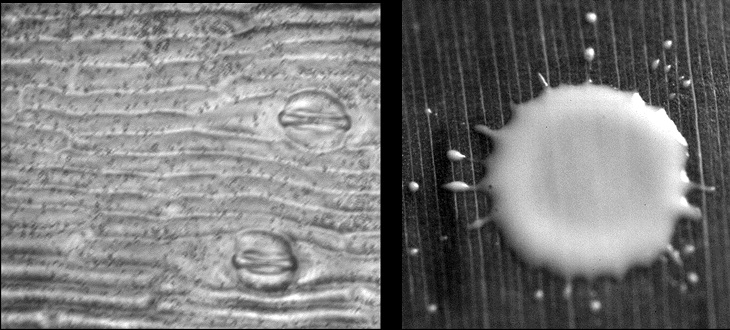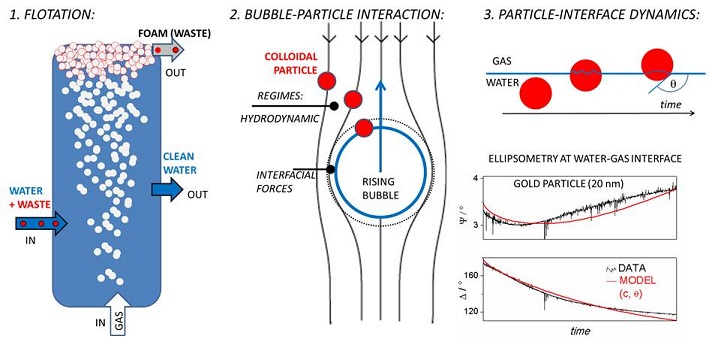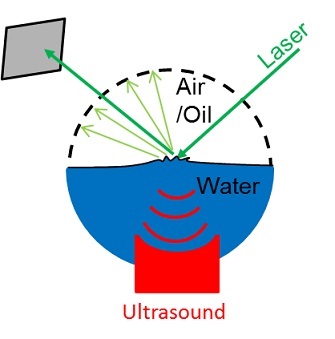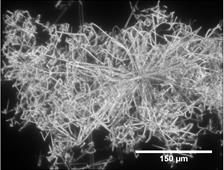Rechercher
Accueil > La Recherche > Axes & Equipes > Matière Molle & Verres > Equipe : Matière Molle > Thème : Matière molle pour l’agronomie et l’environnement
Emulsions, droplets and particles at interfaces for food and environmental applications
publié le , mis à jour le
Emulsions, droplets and particles at interfaces for food and environmental applications
We are investigating selected aspects of interfacial phenomena applied to enviromental and food applications : 1. The physics of spraying, 2. Particle adsorption and transfer in Flotation and Liquid-Liquid extraction, 3. Several routes for thickening healthy edible oils
1. The physics of spraying
People involved : D. Donnarumma (PostDoc), C. Ligoure, L. Ramos
We are interested in the physical and physico-chemical processes involved during the agricultural spraying of liquids on crops. This includes the role of adjuvant (polymer, dilute oil in water emulsions) in the formation and destabilization of spray and the resulting droplet size distribution, and the spreading of emulsions on natural leaves.
Our general approach is first to build model experiments (spreading on model surfaces of the natural leaves, imaging of the dynamics of small model liquid sheets) that allow careful investigations from which physical picture of the phenomena into play emerge, and second compare our model experiments to experiments on conventional sprays and natural leaves.
These projects can be conducted in collaboration with researchers from IRSTEA (UMR ITAP, Montpellier) and with industrial companies (Solvay, La Compagnie Fruitière). We are investigated the structural and mechanical properties of natural products extracted from plants (wheat grain and proteins) or synthesized from plant biomass.

Destabilization of liquid sheets produced with a dilute oil-in-water emulsion (left), with a dilute water-soluble polymer solution (middle), and a mixture of emulsion and polymer (right).

Light microscopy image of a replica of banana leaf (left), and spreading of an emulsion on a natural banana leaf (right).
2. Particle adsorption and transfer in Flotation and Liquid-Liquid extraction
People involved : A. Stocco, M. Nobili, M. In, S. Villa
A new activity related to environmental science devoted to understanding and improving water remediation technologies has started in our Team. Nowadays, water treatment faces new challenges such as the removal of emerging contaminants such as nanomaterials, which old technologies cannot separate. For those systems, phenomena occurring at water interfaces play a key role in the separation stages of filtration, froth flotation, membrane and liquid-liquid extraction units.
Connected to the Theme “Complex Interfaces”, the focus of our research is on particles, from nano to micro sizes, at water interfaces. Optical tweezers, advanced optical microscopy, ellipsometry and surface scattering methods are used to investigate in-situ interfacial dynamics of particles, aiming at studying adsorption, trapping and particle transfer across the water interfaces.
Our approach is to bridge the physics and physical chemistry of colloids, nanoparticles and water interfaces to the engineering of interface based separation processes. In flotation, for instance, rising gas bubbles are used to trap solid particles, which are removed from water in the form of a particle rich foam (or froth) collected on the top of a flotation column. Several dynamics and regimes are encountered in the path travels by the gas bubbles in the water column. Hydrodynamics and interfacial forces play a fundamental role in the interaction between bubbles and solid particle contaminants. Wetting and interface dynamics rule the attachment of particles onto the water surface, see Fig. below. Experiments are thus designed to monitor phenomena occurring at different time and length scales.

Sketch of a flotation column : particulate contaminants are removed on the top as a froth/foam formed by gas bubbles used to trap particles. 2. Regimes of the interaction between a gas bubble and a colloidal particle. 3. Dynamics of particle attachment onto the water interface and ellipsometry measurements for gold particles at the water-air interface.
PARTICLE ADSORPTION.
In a specific project (Stefano Villa’s PhD), we study the dynamics of single ellipsoidal and spherical colloids of few µm sizes in water close to a plane air-water interface within a home-made interferometric setup using a pendant drop geometry. All the particles’ degrees of freedom are measured using particle tracking coupled with interferometry. From the interferometry data we can access the trajectory in the direction perpendicular to the interface, with a resolution of around 10 nm, see Fig. below. This dynamics is of great interest for a better understanding of adsorption and crossing of the air-water interface in floatation.
Sketch of the interferometric setup (left) and time evolution of the distance between the particle and the air-water interface (right).
ULTRASOUND.
We have also explored the use of ultrasounds to transfer ions and nanoparticles across liquid-liquid interfaces relevant for liquid-liquid extraction separation. We started focusing on the effect of MHz ultrasound on the surface roughness of liquid-gas and liquid-liquid interfaces.
The interface between two fluids is never flat at the nanoscale, and this is important for transport across interfaces. In absence of any external field, the surface roughness is due to thermally exited capillary waves possessing subnanometric amplitudes in the case of simple liquids. MHz frequency ultrasound was applied normal to the interface at relatively low ultrasonic pressures (< 0.6 MPa), and the amplitudes of surface fluctuations have been measured by light reflectivity and ellipsometry, see Fig. below. We found a dramatic enhancement of surface roughness with vertical displacements of the interface as high as 50-100 nm. As a consequence, the effective contact area between two fluids can be increased by ultrasound. This result has a clear impact for enhancing interface based processes such as phase transfer in liquid-liquid extraction.

Sketch of a light reflectivity setup to measure the surface roughness generated by MHz ultrasound at the fluid-fluid interface.
Reference :
- MHz ultrasound induced roughness of fluid interfaces
Boubekri R, Gross M, In M, Diat O, Nobili M, Möhwald H, Stocco A
Langmuir Langmuir, 2016, 32 (40), pp 10177–10183
TRANSFER.
We have also investigated the adsorption of responsive nanoparticles at the fluid interface and investigated the bidirectional phase transfer across the oil-water interface.
Multiple angle of incidence ellipsometry was applied to assess the contact angle and surface coverage of gold nanoparticles as small as 18 nm, coated with stimuli-responsive polymers, at water-oil and water-air interfaces in the presence of NaCl and NaOH, respectively, see Fig. below. In absence of hydrodynamic flow, interfacial adsorption of the nanoparticles was found very slow and took days to reach a fairly low surface coverage, which confirmed the existence of an adsorption energy due to electrostatic interactions. Nanoparticle contact angle measurements by ellipsometry were also compared to macroscopic droplet contact angle experiments on planar surfaces. Some differences have been observed and discuss in terms of local contact angle at the colloidal length scale due to long range surface forces such as electrostatic and Van der Waals interactions.

Transfer of gold nanoparticle across a liquid-liquid interface (left). Sketch of an ellipsometry setup to measure the interfacial profile of nanoparticles at the fluid interface (center) ; and free energy landscape across the interface.
Finally, we have organized two workshops “Water Treatment : Physics and Engineering” and “Ultrasound and Fluid interfaces” related to these topics, click !
References :
- In situ assessment of the contact angles of nanoparticles adsorbed at fluid interfaces by multiple angle of incidence ellipsometry
Stocco A., Su G., Nobili M., In M., Wang D.
Soft Matter, vol. 10 p.6999 (2014)
- Bidirectional Nanoparticle Crossing of Oil–Water Interfaces Induced by Different Stimuli : Insight into Phase Transfer
Stocco A, Chanana M, Su G, Cernoch P, Binks BP, Wang D
Angewandte Chemie International Edition 51 (38), 9647-9651 (2012)
3. Several routes for thickening healthy edible oils
People involved : A. Poirier (PhD), A. Banc, M. In, L. Ramos, A. Stocco
Related to their composition in unsaturated versus saturated fatty acids, the most healthy edible oils are often not thick enough for food industry. Classical ways to address this issue include the use emulsification in water and/or the crystallization of additives in otherwise liquid oils. Those two processes are still to be improved in terms of composition and processing. Moreover, these two processes raise questions regarding the interface stabilization by plant proteins (mainly proteins form wheat, sunflower and colza) and the crystallization process in apolar solvents. In the framework of a project funded by the SAS Pivert, we are investigating those two processes from a fundamental perspective and assessing their capability to produce thick edible oils based on colza and sunflower extracts. (Collaboration : F. Leal-Calderon, CBMN, Bordeaux)

Evolution of a protein film at an interface as a function of the surface pressure. Three regimes have been evidenced and characterized for gluten protein at an air/water interface using a combination of techniques (dilatational viscoelasticity and ellipsometry coupled to surface tension measurements).

Co-cristallization of polyphenols derivatives in oil









